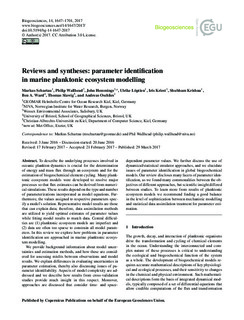| dc.contributor.author | Schartau, Markus | |
| dc.contributor.author | Wallhead, Philip | |
| dc.contributor.author | Hemmings, John | |
| dc.contributor.author | Loptien, Ulrike | |
| dc.contributor.author | Kriest, Iris | |
| dc.contributor.author | Krishna, Shubham | |
| dc.contributor.author | Ward, Ben A. | |
| dc.contributor.author | Slawig, Thomas | |
| dc.contributor.author | Oschlies, Andreas | |
| dc.date.accessioned | 2018-08-02T12:38:54Z | |
| dc.date.available | 2018-08-02T12:38:54Z | |
| dc.date.created | 2018-03-07T08:46:28Z | |
| dc.date.issued | 2017 | |
| dc.identifier.citation | Biogeosciences. 2017, 14, 1647-1701. | nb_NO |
| dc.identifier.issn | 1726-4170 | |
| dc.identifier.uri | http://hdl.handle.net/11250/2507299 | |
| dc.description.abstract | To describe the underlying processes involved in oceanic plankton dynamics is crucial for the determination of energy and mass flux through an ecosystem and for the estimation of biogeochemical element cycling. Many planktonic ecosystem models were developed to resolve major processes so that flux estimates can be derived from numerical simulations. These results depend on the type and number of parameterizations incorporated as model equations. Furthermore, the values assigned to respective parameters specify a model's solution. Representative model results are those that can explain data; therefore, data assimilation methods are utilized to yield optimal estimates of parameter values while fitting model results to match data. Central difficulties are (1) planktonic ecosystem models are imperfect and (2) data are often too sparse to constrain all model parameters. In this review we explore how problems in parameter identification are approached in marine planktonic ecosystem modelling. We provide background information about model uncertainties and estimation methods, and how these are considered for assessing misfits between observations and model results. We explain differences in evaluating uncertainties in parameter estimation, thereby also discussing issues of parameter identifiability. Aspects of model complexity are addressed and we describe how results from cross-validation studies provide much insight in this respect. Moreover, approaches are discussed that consider time- and space-dependent parameter values. We further discuss the use of dynamical/statistical emulator approaches, and we elucidate issues of parameter identification in global biogeochemical models. Our review discloses many facets of parameter identification, as we found many commonalities between the objectives of different approaches, but scientific insight differed between studies. To learn more from results of planktonic ecosystem models we recommend finding a good balance in the level of sophistication between mechanistic modelling and statistical data assimilation treatment for parameter estimation. | nb_NO |
| dc.language.iso | eng | nb_NO |
| dc.publisher | European Geosciences Union | nb_NO |
| dc.rights | Attribution 3.0 Unported (CC BY 3.0) | * |
| dc.rights.uri | https://creativecommons.org/licenses/by/3.0/ | * |
| dc.title | Reviews and syntheses: parameter identification in marine planktonic ecosystem modelling | nb_NO |
| dc.type | Journal article | nb_NO |
| dc.type | Peer reviewed | nb_NO |
| dc.description.version | publishedVersion | nb_NO |
| dc.rights.holder | © Author(s) 2017. | nb_NO |
| dc.source.pagenumber | 1647-1701 | nb_NO |
| dc.source.volume | 14 | nb_NO |
| dc.source.journal | Biogeosciences | nb_NO |
| dc.identifier.doi | 10.5194/bg-14-1647-2017 | |
| dc.identifier.cristin | 1570997 | |
| dc.relation.project | International Space Science Institute | nb_NO |
| cristin.unitcode | 7464,20,14,0 | |
| cristin.unitname | Marin biogeokjemi og oseanografi | |
| cristin.ispublished | true | |
| cristin.fulltext | original | |
| cristin.qualitycode | 1 | |

